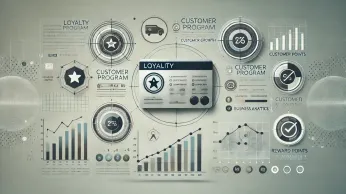Bank Rewards Programs: How Top Banks Are Enhancing Customer Loyalty and Satisfaction with Rewards
Enhance customer retention and engagement with bank reward programs by providing various benefits based on the customer's usage of banking products and services.
On this page
The banking industry, long perceived as a resilient pillar immune to external shifts, is undergoing a profound transformation. According to Forbes, technological advancements, shifting consumer expectations, and heightened competition are driving a digital-first approach that is revolutionizing traditional banking methods. In this rapidly evolving landscape, personalized customer experiences and innovative services are no longer optional—they're essential.
For instance, banks with robust rewards programs have seen remarkable results: U.S. Bank reported a 13.2% increase in average credit card loans due to higher spending volume and improved customer engagement. This success underscores the growing importance of rewards programs in the modern banking sector.
What is a bank rewards program?
A bank rewards program is a strategic tool that is specifically designed to incentivize customer engagement and loyalty. These reward programs offer various tangible benefits to the customers who use the bank’s services and products.
Bank rewards programs are often linked to specific activities, such as using a credit card, maintaining a certain account balance, or making regular transactions. They can also take various forms, such as loyalty points, cashback, discounts, or exclusive access to services. These rewards are not just financial perks; they are integral to how banks build long-lasting emotional connections with their customers.
Currently, the bank rewards program market is at a valuation of USD 1.10 Billion and is expected to reach a staggering USD 2.72 Billion by 2031. This shows the power of bank rewards in transforming transactional banking into a rewarding experience for customers.
3 key challenges to customer retention in banks
Following are the key challenges to customer retention in banks.
1. Digitalization
71% of today’s consumers are preferring digital banking services. Empowered with remote account access and digital wallets, modern customers no longer feel tethered to physical rewards, necessitating banks to offer digital incentives.
2. Personalization
Customers now expect personalized experiences tailored to their unique needs and preferences. They are no longer interested in rewards that do not offer them actual value.
3. Intense competition
The modern banking landscape is fiercely competitive. New industry players are introducing more attractive rewards. This coupled with the increasing customer acquisition cost, retention is now a top priority. This calls for more strategically designed bank rewards programs that stand out from the crowd.
A strategically developed bank rewards program is a top priority for banks to address these challenges.
Benefits of bank rewards programs
The 5 benefits of bank rewards programs are as follows:
- Enhanced customer engagement and retention: Bank rewards programs offer the customers motive and platform to engage more frequently with the bank. This deepens customer engagement, leading to higher satisfaction levels.
- Competitive advantage: In a crowded marketplace, a well-designed rewards program can set a bank apart from its competitors. A Harvard study shows offering well-designed rewards gives a competitive edge, attracting new customers and retaining existing ones.
- Increased relevance: Rewards programs empower the banks to stay relevant in their customers’ lives by offering benefits that align with their interests and needs.
- Increased brand reputation: When customers feel valued and rewarded for their loyalty, they are more likely to share their positive experiences with others.
- Increased customer lifetime value: By encouraging long-term engagement, rewards programs can increase the overall lifetime value of a customer. According to PayPal, 80% of Americans would increase their purchase if provided with suitable rewards programs. As customers continue to use the bank’s products and services to earn rewards, they generate more revenue for the bank.
So, Loyalife provided a comprehensive solution by implementing a digital rewards platform that allowed the bank to offer personalized rewards to its customers.
Loyalife helped the institution design and manage the bank loyalty program that spanned across multiple financial products. Those included, credit cards, debit cards, internet banking, and financing options.
They not only personalized the loyalty experience but created a seamless redemption option with diverse reward choices that resonated with the customers. This initiative improved customer satisfaction and significantly increased customer retention rates.
Data-driven results showed a marked increase in customer participation in the rewards program, leading to higher transaction volumes and overall profitability for the bank.
The successful implementation of this program led to a 146% increase in customer engagement through personalized rewards and a diverse redemption catalog. It also noticed a 170% growth in transaction volume through personalized rewards, a diverse redemption catalog, and a 62% expansion of its user base within just 22 months.
The prominent bank remains an example that showcases that implementing bank rewards can lead to growth in user base, custom engagement, and loyalty. However, you must know the different types of bank-reward programs.
Different types of bank reward programs
The 5 different types of bank reward programs are as follows:
1. Points-based
Points-based programs are the most common bank rewards programs. Customers earn points for specific actions. These points can be redeemed for various rewards, including travel, merchandise, or gift cards.
2. Cashback
Cashback programs offer customers a percentage of their spending back as cash. This type of program is popular because it provides immediate value and gratification, allowing customers to save money on everyday expenses.
3. Tiered
Tiered rewards programs offer increasing benefits as customers move up through different levels based on their engagement with the bank. This influences the customer's decision to stay loyal to a bank and gain access to more exclusive benefits.
4. Coalition loyalty programs
Coalition loyalty programs involve partnerships between banks and other companies. They allow customers to earn and redeem rewards across multiple brands. This type of program adds value by offering a broader range of rewards.
5. Digital wallet
The digital wallet rewards programs are integrated into mobile banking apps and digital wallets. They allow customers to earn and redeem rewards directly through their smartphones. The digital wallet bank reward program is particularly appealing to tech-savvy customers.
Features of the best bank rewards program
Following are the 9 best bank rewards program features:
- Value: A successful bank rewards program must offer compelling, tangible value to customers. This could be in the form of significant savings, exclusive experiences, or valuable merchandise. The perceived value of the rewards is crucial in motivating customers to participate in the program.
- Transparency: Customers appreciate transparency in how rewards are earned and redeemed. Clear communication about how points are accumulated, what they are worth, the criteria for redemption, and the terms and conditions is essential to win their trust and satisfaction.
- Variety: Offering a variety of rewards ensures that the program appeals to a broad customer base. Different customers have different preferences. So, a diverse range of rewards, such as travel benefits, merchandise discounts, cashback, etc., will cater to a wider audience.
- Easy navigation: A user-friendly interface is critical for the success of a bank rewards program. Customers should be able to easily navigate the program, check their points balance, and redeem rewards without confusion or frustration.
- Personalization: Personalization is a valuable key to making customers feel valued. A program that tailors rewards based on individual preferences and behaviors is more likely to resonate with customers and encourage ongoing engagement.
- Promptness: Bank rewards should be delivered promptly and induce instant gratification. Delays in awarding points or processing redemptions can lead to frustration and diminish the perceived value.
- Seamless Integration: A seamless integration between the rewards program and the bank’s other services enhances the overall customer experience. Customers should be able to earn and redeem rewards effortlessly across various platforms. A well-designed bank rewards program will ensure that the customers have a cohesive accessibility and consistent experience.
- Flexibility and adaptability: A successful bank rewards program evolves with market trends and customer feedback, offering dynamic benefits that stay relevant.
- Security and privacy: Ensuring the security and privacy of customer data is paramount. Customers need to trust that their information is safe and that their participation in the rewards program will not expose them to fraud or data breaches. The banks should implement advanced encryption technologies to safeguard sensitive customers to earn their trust and encourage them to participate.
Best practices for setting up bank rewards programs
Setting up a bank rewards program requires a thoughtful approach to ensure customer engagement and long-term success. Here are some best practices to consider:
1. Define objectives aligned with customer needs
Clearly outline the purpose of your rewards program before its launch. Whether the goal is to attract new account holders, encourage higher spending, or drive long-term loyalty, aligning these objectives with customer expectations is crucial. For instance, if the target audience values flexibility, consider a points-based system that allows rewards across categories like gift cards, travel, or merchandise. Setting measurable KPIs, such as customer acquisition rates or redemption volumes, ensures the program stays on track and delivers tangible outcomes.
2. Offer diverse and relevant rewards
A one-size-fits-all approach rarely works in banking rewards programs. Provide a mix of rewards, such as cashback, gift cards, exclusive merchandise, and experiential perks like travel vouchers. The key is to ensure the rewards resonate with your customer base. For example, offering luxury brand merchandise might appeal to premium customers, while shopping vouchers could cater to younger demographics. Providing choice not only enhances customer satisfaction but also drives higher participation rates.
3. Leverage technology for seamless integration
Investing in robust loyalty management technology, such as Giift LBMS, ensures a seamless customer experience. Integrate the rewards program with your banking platforms, including mobile apps and online portals, to make it easily accessible. Advanced technologies also enable personalized reward offerings and track customer behavior for continuous optimization. A user-friendly interface, combined with secure data handling, ensures customers enjoy a frictionless experience while engaging with the program.
4. Focus on personalization to build loyalty
Customers value experiences tailored to their preferences. Use data analytics to understand spending patterns and offer rewards that align with their lifestyle. For example, a frequent traveler might appreciate air miles or hotel vouchers, while a young professional might prefer gadgets or dining discounts. Personalized emails or app notifications for milestones, like birthdays or anniversaries, further enhance customer relationships. Personalization not only boosts engagement but also strengthens loyalty by making customers feel valued.
5. Ensure simplicity and transparency
Complexity in earning or redeeming rewards can deter customers from participating. Keep the program structure simple, with straightforward earning criteria and clear redemption rules. Avoid hidden conditions that might frustrate customers. Transparency builds trust—ensure all terms and conditions, including expiration policies and restrictions, are communicated upfront. For example, displaying real-time points balance and easy redemption options on the banking app encourages frequent usage and boosts customer satisfaction.
6. Continuously monitor and adapt
The success of a rewards program depends on regular evaluation and adaptation. Track metrics like enrollment rates, active users, and redemption volumes to assess effectiveness. Solicit customer feedback through surveys to understand pain points and preferences. For instance, if data shows low redemption rates, consider adjusting point thresholds or adding more appealing rewards. Adapting to market trends and customer needs ensures the program remains relevant and competitive in the long run.
By following these practices, banks can design a rewards program that not only attracts new customers but also fosters deeper loyalty and enhances the overall banking experience.
Measuring the success of a bank reward program
To evaluate the effectiveness of a bank rewards program, banks must focus on metrics that reflect customer engagement, program efficiency, and overall business impact. Here’s how success can be measured:
1. Enrollment and activation rates
The initial metric to evaluate is how many customers are enrolling in the program. A high enrollment rate indicates that the program appeals to your audience. However, activation rates—how many of these enrollees actively participate by earning or redeeming rewards—are equally important. For example, if 80% of new account holders enroll but only 40% actively use the program, this signals a need to refine the incentives or communication strategy.
2. Redemption rates and patterns
The redemption rate measures the percentage of earned rewards that customers redeem. A high redemption rate, such as 70%, shows that the rewards are desirable, and the process is easy to navigate. Additionally, analyzing redemption patterns provides insight into customer preferences. For instance, if most redemptions are for travel vouchers, you might expand that category to cater to demand. On the other hand, a low redemption rate could indicate unappealing rewards or overly complex processes, warranting a redesign.
3. Impact on key banking metrics
Analyze how the program influences core banking metrics, such as:
- Deposit Growth: Are new customers depositing higher amounts to take advantage of rewards?
- Card Usage: Is there an increase in credit or debit card spending linked to reward points?
- Cross-Selling Success: Are program participants adopting additional products like loans, insurance, or savings accounts?For example, if program participants use their credit cards 25% more than non-participants, the program is effectively driving engagement.
4. Customer retention and lifetime value (CLV)
Compare retention rates and lifetime value between program members and non-members. For example, if customers enrolled in the program are staying 2 years longer and generating 30% higher CLV than non-members, this is a clear indicator of success. Additionally, track churn rates to see if the program is effectively preventing customers from switching to competitors.
5. Cost-to-revenue analysis
Assess the program’s financial viability by calculating its cost-to-revenue ratio. Include all associated costs—reward expenses, platform fees, and marketing campaigns—and measure them against the incremental revenue generated by the program. For instance, if the program costs $500,000 annually but generates $2 million in additional revenue, the ROI is significant. A ratio under 1:4 often reflects a sustainable and successful program.
6. Customer feedback and nps (Net Promoter Score)
Direct feedback from participants offers qualitative insights. Use surveys to gauge satisfaction with the program, asking specific questions like:
- How easy was it to redeem rewards?
- Are the rewards valuable or appealing?Track the NPS, which measures customer loyalty and advocacy. For example, if the NPS improves by 20 points after launching the program, it indicates the rewards are resonating with customers.
7. Transaction frequency and volume growth
Monitor if the program incentivizes higher transaction volumes and frequency. For instance, a program that results in a 50% increase in monthly credit card transactions among members demonstrates its success in encouraging repeat engagement. Similarly, track metrics like average transaction value to measure profitability.
8. Competitive advantage
Measure the program’s impact relative to competitors. Has your market share increased since the program’s launch? Are customers leaving competitor banks to join yours due to the program? For example, if customer acquisition rates rise by 15% compared to the previous year, the program may be attracting new clients from competitors.
Run bank rewards programs with LBMS by Giift!
LBMS by Giift understands the unique challenges that banks and financial institutions face in navigating digital transformation, differentiating from competitors, and delivering personalized customer experiences that foster deep, lasting connections.
Why LBMS by Giift?
Seamless integration and real-time analytics: Its loyalty platforms integrate effortlessly with your existing banking infrastructure, offering real-time analytics to empower banks to design dynamic incentive strategies. These strategies not only boost transaction volumes but also attract high-value customers, helping banks stand out in a crowded market.
Transform your loyalty program with LBMS by Giift: It is easy to create a flexible, impactful bank loyalty program tailored to a unique customer base. Whether one is looking for reward transactions or deepening engagement through brand interactions, the solutions of LBMS are built to deliver exceptional digital experiences.
Conclusion
To wrap up, bank rewards programs are key to boosting customer loyalty and engagement in today’s competitive and digital banking environment. By offering personalized and valuable rewards, banks can stand out, retain customers, and drive growth.
With the market for bank rewards programs expanding, adopting flexible solutions like those from LBMS by Giift can help banks stay relevant and succeed. A well-crafted rewards program is a vital tool for any modern bank. Schedule a call with the experts at LBMS by Giift to learn how LBMS can help you stand out and retain customers.
FAQs
1. Which banks give rewards?
Many banks offer rewards programs, including major institutions like Bank of America, Chase, Wells Fargo, and Citibank. These programs typically provide points, cashback, or other benefits for using the bank’s products and services.
2. What bank has the best rewards program?
The best rewards program depends on your needs, but popular options include Chase Ultimate Rewards, American Express Membership Rewards, and Bank of America Preferred Rewards. These programs offer a variety of benefits like points, cashback, and travel perks.
3. What are the different types of rewards for banks?
Banks offer several types of rewards, including points-based programs, cashback, tiered rewards, coalition loyalty programs, and digital wallet rewards. Each type provides different benefits based on customer activities and preferences.
4. Are bank rewards worth it?
Yes, bank rewards can be worth it if you regularly use the bank’s products and services. They offer added value through cashback, discounts, and other perks, which can save you money or provide exclusive benefits.
5. What banks give you free stuff?
Banks like Chase, Wells Fargo, and Capital One often provide free items or services as part of their rewards programs. These can include free access to certain events, merchandise, or even financial services like no-fee transactions.
6. Which bank gives more reward points?
Chase and American Express are known for offering higher reward points, especially through their premium cards. These programs often provide bonus points for specific spending categories like travel or dining.
7. Which banks are offering cash incentives?
Banks such as Bank of America, Citibank, and Capital One regularly offer cash incentives for new customers. These incentives can vary but often involve signing up for a new account or using specific banking services.









